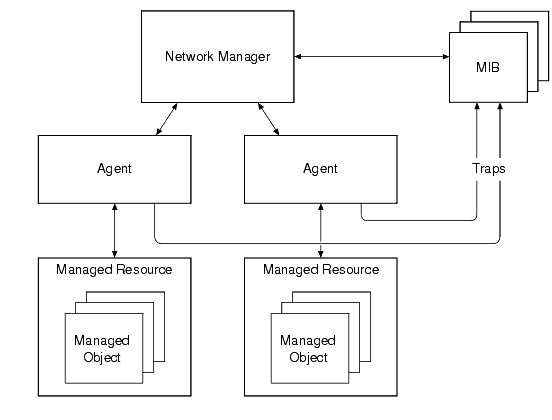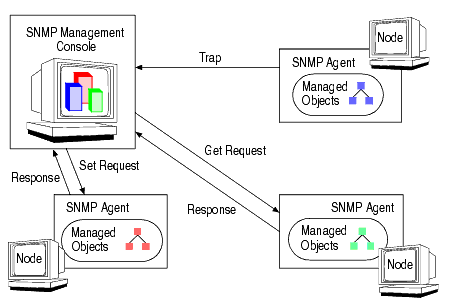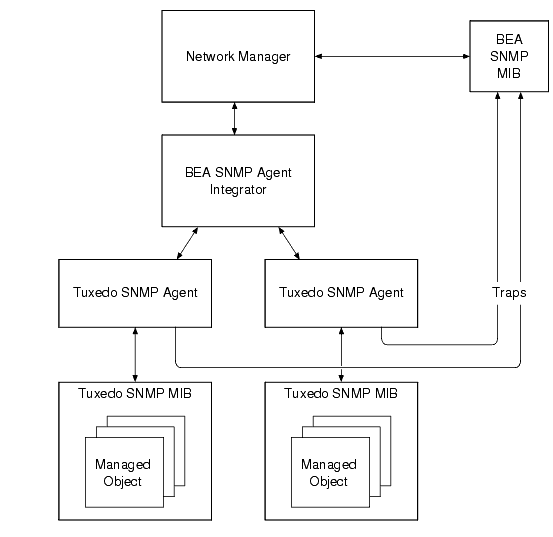









|
The following sections provide an overview of BEA SNMP Agent for BEA Tuxedo, the Simple Network Management Protocol (SNMP), the management information base (MIB), and the BEA SNMP Agent components:
BEA SNMP Agent for BEA Tuxedo, hereafter referred to as "BEA SNMP Agent 10.0" or simply "BEA SNMP Agent," enables SNMP-compliant network management frameworks to manage BEA Tuxedo systems and applications. BEA SNMP Agent complies with the Simple Network Management Protocol version 1 (SNMPv1) specification.
As shown in the following figure, BEA SNMP Agent provides the SNMP links from Tuxedo applications to SNMP-capable management stations (consoles). Also shown in the figure is that BEA SNMP Agent allows multiple SNMP agents and subagents—from any vendor—to operate on the same machine.

BEA SNMP Agent provides the SNMP link from Tuxedo applications to SNMP-compliant network management frameworks (for example, HP OpenView) for monitoring, control, and alarm notification, as follows:
SNMP monitoring allows any supported SNMP-capable management station to monitor the state of the Tuxedo application. Also, appropriate actions can be triggered when a variable crosses a predefined threshold.
An SNMP-capable management framework can modify the value of Tuxedo control and configuration parameters.
The Tuxedo system generates certain system-wide events in case of exceptions (such as a Tuxedo node going down). These events are "trapped" and sent to the management framework.
SNMP is an open network management standard for networks based on the Internet network protocols (TCP/IP). The basic SNMP standard for system management is defined in the Network Working Group (NWG) RFC 1157.
SNMP provides a standard system for classifying system information about hardware, software, and other aspects of a distributed client/server system. SNMP network and systems management is based on the manager/agent model described in the network management standards defined by the International Organization for Standardization (ISO).
In the model, shown in the following figure, a network manager exchanges monitoring and control information about network and system resources with distributed software processes called agents.

Any network or system resource that is manageable through this exchange of information is a managed resource. A managed resource could be a software resource, such as a message queue or a BEA Tuxedo application, or a hardware resource, such as a router or NFS file server.
SNMP enables you to correlate fault and performance data collected by different sources. For example, certain database inserts might fail because the filesystem on which the database resides has become full. This, in turn, might cause a BEA Tuxedo service to fail.
For a management framework to correlate this failure information with other aspects of system information and thus enable pro-active management of the system, all pieces of management information need to be available from the same management console. To achieve this level of correlation, a standardized method of communicating management information is required.
SNMP provides that standardized method. SNMP provides a unified way of representing information about the manageable features of the heterogeneous components of large distributed systems because it is an open network management standard for networks.
Agents function as "collection devices" that typically gather and send data about the managed resource in response to a request from a manager. In addition, agents often have the ability to issue unsolicited reports to managers when they detect certain predefined thresholds or events on a managed resource. In SNMP terminology, these unsolicited event reports are called trap notifications.
An SNMP manager relies upon the management information base (MIB), a database that contains definitions and information about the properties of managed resources and the services the SNMP agents support. When a new agent is added to extend the manager's domain, the manager must be provided with a new MIB component that defines the manageable features of the resources managed through that new agent.
The manageable features of resources, as defined in an SNMP-compliant MIB, are called managed objects (also termed management variables or variables). Examples of managed (or MIB) objects include the state of a BEA Tuxedo domain, the number of users currently logged on to a BEA Tuxedo system, Tuxedo processes, and Tuxedo application variables. When the heterogeneous components of an enterprise's distributed systems are defined within a common MIB on the management framework, a unified perspective and single access point is provided for managing system and network resources.
The data types and the representations of resources within a MIB, as well as the structure of a particular MIB, are defined in a standard called the Structure of Management Information (SMI). This standard is described in the NWG RFC 1155.
A formal language, known as the ISO Abstract Syntax Notation One (ASN.1), is used to describe MIB data independently of any encoding technique used. SNMP uses a subset of the ASN.1 language to represent a MIB.
The following figure shows an example SNMP installation that provides system administrator access to management information from a management console. Management commands are issued to SNMP agents to collect the values of various management variables (as defined in the platform's MIB).

Within most management frameworks, you can set up conditions to generate alarms based on defined event criteria. The criteria typically consist of changes in the values of certain attributes of the managed resources. These attributes are represented as MIB objects. You can also define the action to be taken when a specified event occurs, such as when a particular threshold is crossed.
The BEA SNMP MIB supports a full range of BEA Tuxedo system and application events. These system and application events are transmitted as enterprise-specific traps. See the BEA Tuxedo SNMP Agent MIB Reference for more information about the BEA SNMP MIB.
SNMP protocol is based on request/response commands. A management framework sends a Get or GetNext command to request values of MIB variables from an agent, or a Set request to modify the value of a variable. Once the data is collected, management frameworks can present views or graphs of the information or take action in response to the information provided by SNMP agents.
Typically, management frameworks save the collected data to a repository for historical reporting. They also commonly include various tools and utilities to analyze the management data. The management framework enables you to automate responses to event-based operations, change access privileges, update application information, and tune application parameters.
Because BEA Tuxedo applications are part of an overall organization or business middleware solution, integrating them with SNMP enables you to effectively manage all your large-scale applications using the SNMP-compliant network management tool of your choice. Since most management frameworks support SNMP, BEA SNMP Agent for Tuxedo applications can be integrated into virtually every management framework. Examples of such management frameworks include:
With these management frameworks, you can manage and control systems, databases, applications, and user access from a centralized management console. The tools available from the management framework enable you to automate and delegate routine and complex system tasks.
Using SNMP to manage BEA Tuxedo applications provides the following benefits:
BEA SNMP Agent consists of the following major components:
The following figure shows how the Tuxedo SNMP agent, the BEA SNMP Agent Integrator, and the BEA SNMP MIB work together to incorporate Tuxedo information within an SNMP management framework.

| Note: | The BEA SNMP Agent component files reside in the tux_prod_dir/bin directory and the tux_prod_dir/udataobj/snmp/etc directory, where tux_prod_dir represents the directory in which the BEA Tuxedo 10.0 distribution is installed. |
The Tuxedo SNMP agent, named tux_snmpd, responds to requests from SNMP managers and generates SNMP trap notifications for Tuxedo system and application events. The tux_snmpd executable translates management information for Tuxedo applications into a form compatible with SNMP, and stores the information in a local SNMP MIB for later access by the SNMP manager (a front-end process running in the SNMP network management framework).
The tux_snmpd executable can be started as an SNMP agent or an SNMP multiplexing (SMUX) subagent. The SMUX protocol is defined in RFC 1227.
The BEA SNMP Agent Integrator, named snmp_integrator, provides both SNMP master agent and SMUX master agent capabilities. As such, the snmp_integrator executable enables multiple SNMP agents and SMUX subagents from any vendor to coexist on the same managed node (machine) and appear as a single SNMP agent to the SNMP manager.
BEA SNMP Agent provides the following two SNMP MIB files.
The SNMP MIB, created from the bea.asn1 and mib.txt files, makes the features of the following components manageable within an SNMP network management framework:
You can use BEA SNMP Agent 10.0 and the SNMP MIB to manage Tuxedo 10.0, 9.1, 9.0, 8.1, 8.0, 7.1, and 6.5 applications. You cannot use BEA SNMP Agent 10.0 and the SNMP MIB to manage WebLogic Enterprise 5.1 or earlier applications.
For more information about the BEA SNMP MIB, see BEA Tuxedo SNMP Agent MIB Reference.
BEA SNMP Agent provides the following two configuration files.
For more information about the BEA SNMP Agent configuration files, see Configuration Files.
The BEA SNMP Agent software provides the following commands to control tux_snmpd and snmp_integrator processes.
The BEA SNMP Agent software provides the following utilities to install and test tux_snmpd and snmp_integrator processes:
For more information about the BEA SNMP Agent commands and utilities, see BEA SNMP Agent Integrator Commands.


|